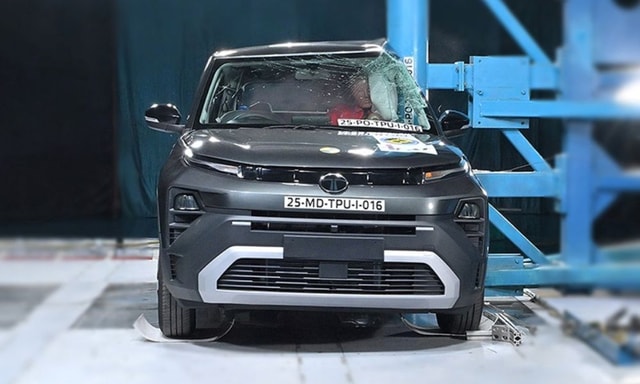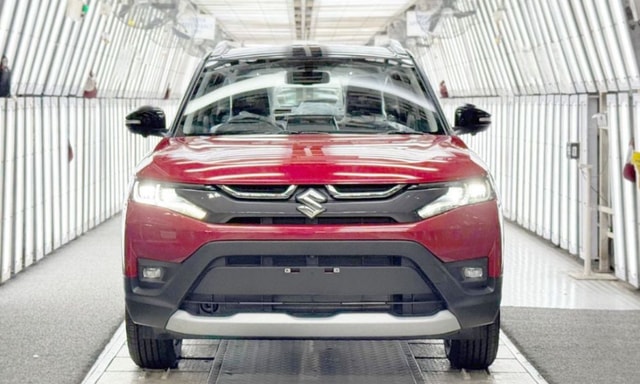What Is Aquaplaning and How to Avoid It?

- Aquaplaning occurs commonly on water-laden roads
- Keeping a calm head is absolutely essential in an 'aquaplaning' situation
- Keep an eye on the condition of the tyres on your car in monsoon
Monsoon is almost upon us and this means water laden roads all over the country. It would be difficult to believe that the rain water, which stays on roads so harmlessly, holds major potential for accidents. All thanks to a phenomenon known as aquaplaning or hydroplaning.
What basically happens is that a thin film of water is formed between the tyres of a car and the tarmac. This happens because the pressure that water lying on the road exerts becomes more than the pressure that the tyres exert on the road. This happens just for a fraction of a second but that is more than enough for you to lose control of the car. Basically, the car loses the grip that the tyres generate from the tarmac. Even steering inputs fail to register and the brakes are rendered useless because the tyres are spinning freely. This means that the car is likely to spin off the road or crash into oncoming traffic, if it is there. Yes! It's danger lurking on a harmless looking road with water on it.
 (Image courtesy: wheelwright.co.uk)
(Image courtesy: wheelwright.co.uk)Prevention is always better than cure
There are ways to reduce the risk of aquaplaning when driving in the rains. For starters, make sure that the tyres on your car are inflated as per the manufacturer's prescription. Underinflated or overinflated tyres will dispel water in a haphazard way, which increases the risk of aquaplaning. Secondly, if you see that the tyres of your car are worn out and have negligible tread, change them, at the earliest. There is nothing worse than a bald tyre on a wet rainy day. It will only serve to make your day even gloomier. Thirdly, if you see standing water on the roads, slow down your speed before you enter the puddle. The lesser the speed, the lesser the risk of aquaplaning. Yes! Everybody loves to splash water all around while driving through a puddle but we suggest you taking it easy. Another way to prevent aquaplaning is if the spray from the tyres of car in front of you suddenly increases, it might mean that the car ahead is experiencing aquaplaning.
How do you know whether your car is experiencing aquaplaning?
In case of aquaplaning, you will feel that the steering has become lighter. The RPMs might rise momentarily. The car might suddenly veer in a different direction than the intent of travel.
What to do in case you find yourself 'aquaplaned'
Keeping a calm head is absolutely essential to deal with aquaplaning. First and foremost, stay away from the brake and the accelerator pedal. Step on either and chances are that you will worsen the situation and make the car go in an uncontrolled skid. Secondly, do not provide any steering inputs. Chances are the moment you regain traction after an aquaplaning moment, you might lose it again because the wheels are facing in the direction opposite to the travel. Grip the steering tight and let the car go in the direction its going. It is best to wait it out than doing anything because usually aquaplaning situations are momentary.
Latest News
 Jaiveer Mehra | Jan 20, 2026Tata Punch Facelift Bharat NCAP Crash Test Scores Revealed; Gets 5-Star RatingFacelifted internal combustion Punch secures 30.58 out of 32 for adult occupant protection and 45 out of 49 for child occupant protection.1 min read
Jaiveer Mehra | Jan 20, 2026Tata Punch Facelift Bharat NCAP Crash Test Scores Revealed; Gets 5-Star RatingFacelifted internal combustion Punch secures 30.58 out of 32 for adult occupant protection and 45 out of 49 for child occupant protection.1 min read Seshan Vijayraghvan | Jan 20, 2026Maruti Suzuki To Invest Rs. 35,000 Crore For Setting Up New Manufacturing Plant In GujaratThe new facility will come up in Khoraj, on 1,750 acres of land provided by Gujarat Industrial Development Corporation (GIDC).2 mins read
Seshan Vijayraghvan | Jan 20, 2026Maruti Suzuki To Invest Rs. 35,000 Crore For Setting Up New Manufacturing Plant In GujaratThe new facility will come up in Khoraj, on 1,750 acres of land provided by Gujarat Industrial Development Corporation (GIDC).2 mins read car&bike Team | Jan 20, 2026Bajaj Pulsar 125 Updated With LED Headlamp, Indicators; Prices Start From Rs 89,910Updates are limited to the Pulsar 125 Carbon Fibre series.1 min read
car&bike Team | Jan 20, 2026Bajaj Pulsar 125 Updated With LED Headlamp, Indicators; Prices Start From Rs 89,910Updates are limited to the Pulsar 125 Carbon Fibre series.1 min read Seshan Vijayraghvan | Jan 20, 2026All-Electric Toyota Urban Cruiser EBella Introduced; Booking Open For Rs. 25,000Prices for the Toyota Urban Cruiser eBella are yet to be announced, but bookings are open at Rs. 25,000.1 min read
Seshan Vijayraghvan | Jan 20, 2026All-Electric Toyota Urban Cruiser EBella Introduced; Booking Open For Rs. 25,000Prices for the Toyota Urban Cruiser eBella are yet to be announced, but bookings are open at Rs. 25,000.1 min read Jaiveer Mehra | Jan 20, 2026Skoda Kodiaq RS India Launch In Q2 2026; Additional 100 Units Of Octavia RS India-BoundAside from debuting the facelifted Kushaq in India, Skoda had some big product announcements for the year, including a second batch of Octavia vRS and the new Kodiaq vRS.2 mins read
Jaiveer Mehra | Jan 20, 2026Skoda Kodiaq RS India Launch In Q2 2026; Additional 100 Units Of Octavia RS India-BoundAside from debuting the facelifted Kushaq in India, Skoda had some big product announcements for the year, including a second batch of Octavia vRS and the new Kodiaq vRS.2 mins read Jaiveer Mehra | Jan 20, 20262026 Skoda Kushaq Facelift Revealed With New Tech, Powertrain Updates2026 Kushaq gets a notable styling refresh, new features and a new 8-speed automatic gearbox option for the 1.0 TSI engine.3 mins read
Jaiveer Mehra | Jan 20, 20262026 Skoda Kushaq Facelift Revealed With New Tech, Powertrain Updates2026 Kushaq gets a notable styling refresh, new features and a new 8-speed automatic gearbox option for the 1.0 TSI engine.3 mins read
 Amaan Ahmed | Jan 17, 2026Bajaj Chetak C25 First Ride Review: Basic, Likeable E-Scooter For First-Time RidersThe Chetak C25, in quite a few ways, is poles apart from the larger and more powerful 30 and 35 Series models, but in its mannerisms, it is very much a Chetak.8 mins read
Amaan Ahmed | Jan 17, 2026Bajaj Chetak C25 First Ride Review: Basic, Likeable E-Scooter For First-Time RidersThe Chetak C25, in quite a few ways, is poles apart from the larger and more powerful 30 and 35 Series models, but in its mannerisms, it is very much a Chetak.8 mins read Bilal Firfiray | Jan 9, 2026Toyota Urban Cruiser Hyryder: 10,000 km Long-Term ReviewAfter spending over three months and 10,000 km with the Toyota Urban Cruiser Hyryder Hybrid, we were impressed by its real-world mileage, seamless hybrid, practical comfort, and Toyota reliability. Is it the best C-SUV then?5 mins read
Bilal Firfiray | Jan 9, 2026Toyota Urban Cruiser Hyryder: 10,000 km Long-Term ReviewAfter spending over three months and 10,000 km with the Toyota Urban Cruiser Hyryder Hybrid, we were impressed by its real-world mileage, seamless hybrid, practical comfort, and Toyota reliability. Is it the best C-SUV then?5 mins read Seshan Vijayraghvan | Jan 8, 20262026 Mahindra XUV 7XO Review: Big On Tech, Bigger On ComfortThe new Mahindra XUV 7XO is flashier, feature packed, and comes with more advanced tech. But are the changes just incremental or actually substantial?1 min read
Seshan Vijayraghvan | Jan 8, 20262026 Mahindra XUV 7XO Review: Big On Tech, Bigger On ComfortThe new Mahindra XUV 7XO is flashier, feature packed, and comes with more advanced tech. But are the changes just incremental or actually substantial?1 min read Preetam Bora | Jan 10, 2026Simple One Gen 2 First Ride Review: 265 km Claimed Range!The Gen 2 model of Simple Energy’s first electric scooter gets a fair few updates, including new features, tech, more range and lighter weight. We spent a couple of hours with the Simple One Gen 2 to find out if it manages to impress.6 mins read
Preetam Bora | Jan 10, 2026Simple One Gen 2 First Ride Review: 265 km Claimed Range!The Gen 2 model of Simple Energy’s first electric scooter gets a fair few updates, including new features, tech, more range and lighter weight. We spent a couple of hours with the Simple One Gen 2 to find out if it manages to impress.6 mins read Amaan Ahmed | Jan 3, 2026VLF Mobster 135 300 KM Review: Fun But FlawedA 125 cc scooter with Italian design and Chinese genes is a rare combination, and while some may be tempted to dismiss it because of its origins, the VLF Mobster shows 125s can also be exciting – but not without compromises.11 mins read
Amaan Ahmed | Jan 3, 2026VLF Mobster 135 300 KM Review: Fun But FlawedA 125 cc scooter with Italian design and Chinese genes is a rare combination, and while some may be tempted to dismiss it because of its origins, the VLF Mobster shows 125s can also be exciting – but not without compromises.11 mins read




















































































































